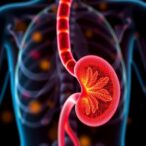The cell cytoskeleton is modulated by motor proteins, known as dyneins, that generate force and movement on microtubules to control a wealth of biological processes, including motility, cell division, and intracellular transport.
Mutation of Lis1, a key dynein regulator, can lead to the rare mental developmental disorder lissencephaly, or “smooth brain,” where the brain’s surface lacks the normal folds and grooves, for which there is no cure.
In a new paper published in Nature Structural and Molecular Biology titled, “Multiple steps of dynein activation by Lis1 visualized by cryo-EM,” researchers from the Salk Institute and University of California, San Diego (UCSD), have catalogued new high resolution Lis1 and dynein protein dynamics to guide the design of neurological drugs. Using a yeast model, the team solved 16 new structural conformations of dynein-Lis1 by cryo-electron microscopy (cryo-EM) to inform precise atomic locations for drug targeting.
“Our approach to imaging dynein and Lis1 is more comprehensive than any previous study on this protein,” said co-corresponding author Andres Leschziner, PhD, professor at UCSD. “By capturing movies rather than pictures, we confirmed 16 detailed, 3D shapes that dynein takes as it interacts with Lis1, several of which are entirely unique to our study.”
Dynein belongs to the ATPase associated with various cellular activities (AAA+) family of proteins and uses the energy from ATP hydrolysis to generate force and movement. Dynein exists predominantly detached from the microtubule in the autoinhibited “Phi” or “locked” conformation in cells. Recent studies suggest that Lis1 has crucial roles in dynein activation (“unlocked” state) and complex assembly. Based on evidence that dynein mutants locked in a microtubule-unbound state bind to Lis1 with a stronger affinity than their microtubule-bound counterpart, Lis1 is suggested to regulate dynein before dynein interacts with microtubules. However, the precise structural mechanism of dynein activation remains unclear.
While previous studies have used cryo-EM and other imaging methods to construct images of dynein in its locked and unlocked states individually, the Salk and UCSD authors present a time-resolved capture that identifies a series of structures over time to create a movie of dynein movement. The movie documents the step-by-step transition toward dynein activation by identifying the sub-second changes in structure.
The dynein complex is composed of a dimer of two motor domains and two copies each of five accessory chains (an intermediate chain, a light intermediate chain, and three light chains). Its heavy chain includes a motor domain composed of six AAA+ modules. Each AAA module is composed of a large and small domain, with nucleotide binding taking place in a groove between them and the large domain of the adjacent AAA module.
The authors suggest that Lis1 relieves dynein autoinhibition by increasing its basal ATP hydrolysis rate to promote conformations compatible with complex assembly and motility. The data support a hypothesis in which Lis1 promotes dynein activation by facilitating a nucleotide exchange in AAA3, potentially priming dynein for complex assembly.
“The impressive tools we have today in the lab made it possible for us to create a movie of dynein and Lis1 interacting in real time. Having this detailed view of their stepwise partnership will help us find ways to restore their activity in neurodevelopmental and neurodegenerative diseases,” said Agnieszka Kendrick, PhD, assistant professor at Salk and co-corresponding author of the study.
The new high-resolution, 3D structural insight into dynein and Lis1 could pave the way for treating their dysfunction in neurodevelopmental and neurodegenerative diseases. Future studies will explore how different mutations to Lis1 affect its interactions with dynein and contribute to lissencephaly and other rare genetic disorders.



